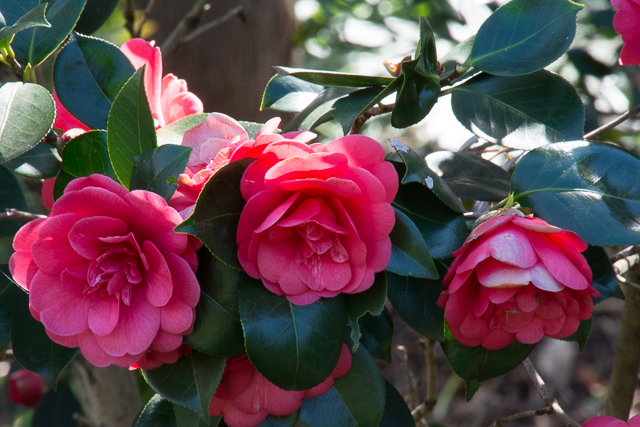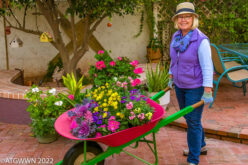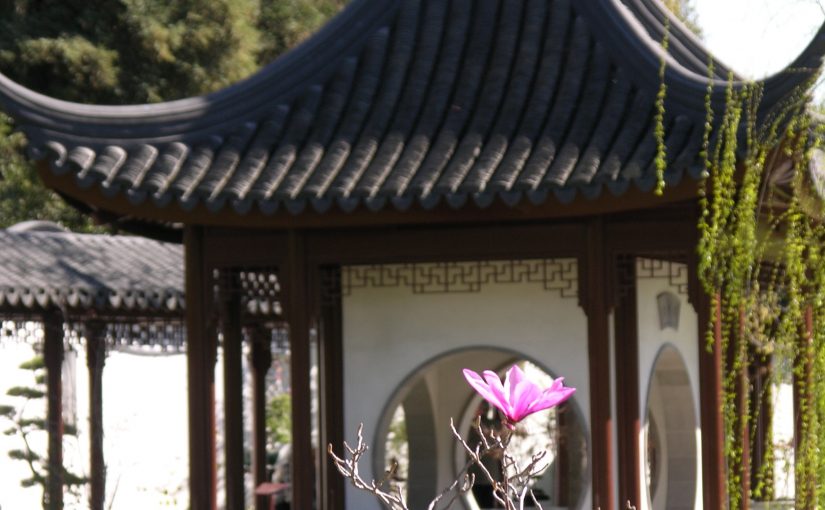Is the spring light warm yet
For a plum blossom flower? Wang Wei (701-761)
In the early morning looking through my window I glimpse a bit of my garden; the flowers, some grass, a tree. Each day I look through the same window and think this is the garden! Yet like a living painting, the light shifts, seasons change and so does the view. The garden grows, declines and remerges in new growth. The window frames my view. Outside looking in is the same garden but a different view. I stand in the grass, under my tree looking toward the window. The window is significantly smaller, the flowers fill the view, the grass and tree are no longer in the picture. My position changes my viewpoint.
 There is no more fascinating and beautiful place to experience the significant difference in views than the Lattice Windows in the Wall of Colorful Clouds in the Chinese Garden at theHuntington Library, Art Collections and Botanical Gardens near Pasadena, CA.
There is no more fascinating and beautiful place to experience the significant difference in views than the Lattice Windows in the Wall of Colorful Clouds in the Chinese Garden at theHuntington Library, Art Collections and Botanical Gardens near Pasadena, CA.
The Lattice Windows in the undulating Wall of Colorful Clouds is a highlight of the Garden of Flowing Fragrances, Liu Fang Yuan. The windows themselves are works of art. Each of the 25 windows is unique with stylized patterns of flowers, petals and geometric forms dating back to the 16th century, according to June Li, curator of the Chinese Garden.
 Chinese gardens are seen as 3 dimensional paintings with early gardens designed by artists. Each window looks out to a framed space in the garden. In Spring a window reveals pink peach blossoms or the fresh golden stocks of bamboo. Here too the view changes with the season as the blossoms fall, symbolizing the transient time of beauty, fresh green leaves shoot out, and fruit forms in time. In winter the view is of bare, brown branches and it is from this the beautiful peach blossoms flower.
Chinese gardens are seen as 3 dimensional paintings with early gardens designed by artists. Each window looks out to a framed space in the garden. In Spring a window reveals pink peach blossoms or the fresh golden stocks of bamboo. Here too the view changes with the season as the blossoms fall, symbolizing the transient time of beauty, fresh green leaves shoot out, and fruit forms in time. In winter the view is of bare, brown branches and it is from this the beautiful peach blossoms flower.
This Chinese Garden, the result of an over 10 year collaboration of Chinese Scholars, Artisans, Horticulturalists and Seismic Engineers, opened in February of 2008. These creative minds, brought together by the Huntington’s mission of education in the arts, humanities, and botanical sciences, and working in multiple languages and dual measurement systems, have designed perhaps the finest Chinese Garden outside of China.
Inspired by the scholarly gardens of Suzhou, China and the ideals of a cultivated life this garden aspires to bring plants, history, symbolism and the arts to the West to increase the understanding of China. It brings the gardens of China to the people of Chinese ancestry living in America. In Suzhou “The private garden was a place where the philosopher within us sat to contemplate and balance Nature’s inner and outer energies in a garden arrangement of the elements, colors, scents, and a variety of viewpoints, through deep thought and light spirit.”(Manchester Metropolitan University)

A Chinese garden is layered with meanings and symbolism. The Flowing Fragrance Garden or Liu Fan Yuan takes part of its name from the Chinese poet Cao Zhi (192–232) as he described “flowing fragrance” as the goddess walked through the scented flora. Inside the garden the fragrance of flowers, leaves and soil stimulate the senses opening the mind to contemplation.
The design of the garden provides a sanctuary for the mind. When you are in the garden you are in a space void of urban distractions. Following along the path you come to the thatched “Pavilion to Wash Away Thoughts.” Water symbolizes the ever changing journey of life and reflects the clouds, sky and moonlight. The Plantain courtyard is a mosaic of rocks in shades of black and gray from Lake Tai Hu laid in place by the hands of visiting Chinese artisans. Rocks symbolize the eternal.
“China did not experience an ice age and the horticulture there was used to build much of our gardens as we know them today. There are over 35,000 Chinese plants. Chrysanthemum, Camellia, Lotus, Bamboo, Roses, Hydrangea and many more garden stalwarts originated in China.” (Manchester Metropolitan University)
A journey to China is a long trek. If you seek to enjoy a Chinese Garden, the Huntington Gardens in CA will show you the plants, poetry and art, without such a long trip. Look through the lattice windows, change your view from inside to outside, and consider the insight you gain from multiple viewpoints. Truly seeing and experiencing it could take as long as a trip to China!
originally published in Roots & Shoots http://cals.arizona.edu/maricopa/garden/mgcentral/uploads/June10.pdf




